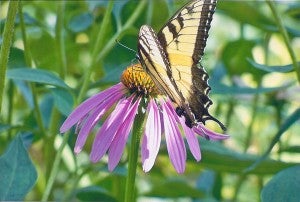Attracting butterflies to your garden
Published 9:05 am Saturday, August 4, 2012
Column: Carol Hegel Lang, Serendipity Gardens
As I gaze out at my gardens I am thrilled to see the butterflies as they flutter from one flower to the next gathering nectar. As they drink, sacs of pollen will stick to their legs and then be spread to the next flower to pollinate it. When you plant your garden you will need to make sure you provide not only flowers for them to have as a food source but also a host plant where they will lay their eggs.
Understanding the different life cycles a butterfly goes through will help you in your plant selection. An adult butterfly will look for just the right plant on which to lay her tiny eggs, some may only lay one egg on a leaf while others lay them in clusters. This egg will turn into a caterpillar that is born very hungry. He will shed his skin several times in about two weeks. The next stage is a chrysalis that you will usually find attached to a branch. This stage takes about 10 days for the chrysalis to develop. And then a new butterfly will emerge. He will need to sit in the sun to spread his wings and let them dry. The adult life of a butterfly is only about two weeks, although the cabbage butterfly will only live a week.
So when you plan your beautiful and colorful garden remember that you also need to include a host plant for the butterfly to lay their eggs on. Three of the easiest to include are dill, parsley and bronze fennel. These will be the host plant for the swallowtail butterflies. The monarch butterfly requires milkweed, whether you plant orange butterfly weed or pink swamp milkweed doesn’t matter. The red admiral requires nettles, which can include stinging nettles and false nettles (Boehmeria cylindrical). If you have stinging nettles you would want to make sure you have them in a location that is not in your garden but still in sun.
Other host plants for butterflies include pink or white turtlehead, Western bleeding hearts, hollyhocks, snapdragons, nasturtiums and thistle. Willow attracts mourning cloaks and elms attract Eastern commas. Fritillaries need native violets for laying their eggs.
One of the most important things to remember is not to use pesticides in your garden if you want butterflies and moths. Butterfly populations increase and decrease periodically but pesticides and organic products can be deadly to caterpillars and adults. Insecticides are harmful, and so are herbicides to butterflies and their sources of food and where they lay their eggs.

Carol Hegel Lang took this photo of a yellow swallowtail butterfly sipping nectar from a coneflower.
So now we get down to the good part; discussing what flowers to add to your garden to attract butterflies. In my garden the two biggest attractions would be tall garden phlox and tithonia which really seems to attract the most butterflies. Aster, verbena bonariensis, yarrow, liatris, Shasta daisy, coreopsis, butterfly weed, chives, marigolds, coneflowers and heliotrope are just a few colorful plants to choose from. I have always been told that butterflies are attracted to plants with flat heads on them so they have a good place to sit while sipping nectar. Maybe that is true but don’t tell that to the monarchs that flock to the pendants of kiss-me-over-the garden-gate as they hang perilously sipping nectar in my gardens.
As soon as the Joe-Pye weed blooms it will be covered with butterflies. I have them spread across the oval garden and along the fence line since butterflies like to have drifts of plants to feast on. This year in the cutting garden I planted a whole row of cosmos so we will see if that attracts more butterflies than the usual half dozen plants that I put in. Zinnia would be another excellent selection for your garden along with the perennial bee balm. Lantana is a favorite of mine along with heliotrope, and they both seem to really draw in the butterflies. You might want to add petunias, statice, globe thistle, catmint, ageratum and sneezeweed. You’ll be surprised at the variety of plants that will welcome butterflies to your garden.
This year I finally tried putting slices of watermelon on a clay saucer and was shocked at the amount of butterflies it attracted. I cut the watermelon into small chunks and then froze them in baggies so that I could put out fresh watermelon daily. Word of warning here: the fruit will attract bees, wasps and fruitflies, so put it somewhere not close to the garden or where children will be playing so you don’t get stung. Butterflies love fermented or rotted fruit, overripe bananas, cantaloupe and orange halves. You can also feed butterflies peaches, pears and apples. As the fruit ferments it will boost the sugar levels in the fruit and as the flesh softens it will be easier for them to sip up with their proboscis.
Puddles of water provide minerals from the mud that forms along the edges. I recently came across a butterfly refreshment recipe that I plan on trying. The recipe was a 20 ounces sport drink (any flavor) and two cups of sugar. Heat the sport drink and sugar in a pan until mixture boils and remove from heat. After it cools, add two Tablespoons of regular soy sauce (it has amino acids and enzymes to keep butterflies healthy) and mix. Pour onto a sponge or paper towel in a saucer or sprinkle over sand or soil. Serve immediately and leftovers should be stored in the refrigerator up to three months. I’ll let you know what the butterflies think of this concoction later.
Now it is time to sit back and await the butterflies as they flock to your gardens, and make sure to have your camera ready so you can get some photos too.
“Happiness is a butterfly, which when pursued, is always just beyond your grasp, but which if you will sit down quietly, may alight upon you.” — Nathaniel Hawthorne.
Carol Hegel Lang is an Albert Lea resident and local green thumb. Her email is carollang@charter.net.


